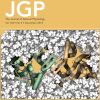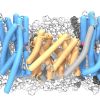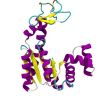
Summer 2018 Mini Workshops
This summer’s mini-workshop series is designed to provide introductions to various topics of interest to lab members. Weekly topics are chosen based on interest levels of lab members.

This summer’s mini-workshop series is designed to provide introductions to various topics of interest to lab members. Weekly topics are chosen based on interest levels of lab members.

The APS 4 Corners Section Meeting is held annually and will be hosted at Colorado State University on October 20th and 21st. Oliver was invited to present the group’s research on Structure and function of electrogenic sodium/proton antiporter membrane proteins.

A new crystal structure of the Escherichia coli NhaA dimer reveals a previously unidentified salt bridge between two highly conserved residues at the putative binding site. The combination of structural data with molecular dynamics simulations yields new insights into the transport mechanism.

This summer’s Lab Book Club is designed to provide a thorough review of fundamental concepts for understanding biomolecular simulation and, in particular,molecular dynamics simulations (MD). The material is primarily based on chapters from Statistical Mechanics: Theory and Molecular Simulation by Mark Tuckerman.

The work in the lab was featured in the Winter 2014 edition of the A2C2 Quarterly newsletter.

We show that one of the best-studied secondary active transporters, the lactose permease LacY, goes through an occluded conformation during its transport cycle. We propose an atomically detailed model of the apo-occluded state. The simulations predict the formation of a transient salt bridge that has been hypothesized in the canonical model for transport of LacY. The simulations are validated by comparison to experimental EPR DEER data, using a new approach to simulate spin-label distance distributions through post-processing of molecular dynamics trajectories. We also define a set of order parameters that consistently classify all known MFS transporter structures as outward-open, occluded, or inward-open conformations.

In a combined X-ray crystallography/biochemistry/molecular simulation study published in Nature we present the structure of the sodium/proton antiporter NapA in its outward facing conformation. Together with the inward facing conformation of the related transporter NhaA we can now understand the conformational changes required for the sodium/proton antiport mechanism.

Structures of membrane proteins can be obtained by the experimental technique of X-ray crystallography. However, proteins are typically not crystallized in their native environment, the lipid membrane. Molecular dynamics simulations of the protein in the membrane provide a realistic model of the interactions between transporter and lipid bilayer.

A tutorial that teaches you to perform and analyze a molecular dynamics simulation of the the enzyme adenylate kinase (AdK) with the Gromacs simulation package.

Molecular dynamics (MD) is a computational method to compute the trajectories of a large number of particles that interact with each other. Classical MD approximates interactions between atoms by classical forces but fully quantum mechanical MD has also been carried out. Experimental observables are calculated from trajectories using statistical mechanics.

Long Liang majored in Biology in his undergraduate study, and shifted to Physics for his PhD study. He hopes to combine his background in Biology and Physics to understand life in terms of the more fundamental Physical laws. In his rotation project he worked on constructing a validated model of a human neurotransmitter transporter. Long is now part of the Complex Materials Group and works on his PhD under Professor Yang Jiao.

Ian Welland graduated from ASU with a degree in physics in Summer 2015 and started in the Joint CMU-Pitt Ph.D. Program in Computational Biology in Fall 2015. During his time in Beckstein Lab, Ian worked on the problem of how to quantitatively describe and analyze the solvation of macromolecules

MDAnalysis is an open source, versatile, object-oriented Python library for analyzing molecular dynamics trajectories. It makes it easy to access trajectory data from Python code by interfacing trajectory readers (and writers) with NumPy arrays and to select atoms via a expressive selection syntax. The CHARMM/NAMD, Amber, Gromacs trajectory formats are all supported as well as PDB, GRO, CRD, PQR, and a range of others.

Many proteins in the living cell can be understood as molecular machines that use a source of energy to produce mechanical or chemical work. My lab’s primary interest is in those proteins located in the cell membrane that move nutrients, signalling molecules, or waste products into and out of the cell. We study their molecular mechanisms of action by detailed molecular dynamics simulations, which provide a “movie” of full atomic detail of a working protein.